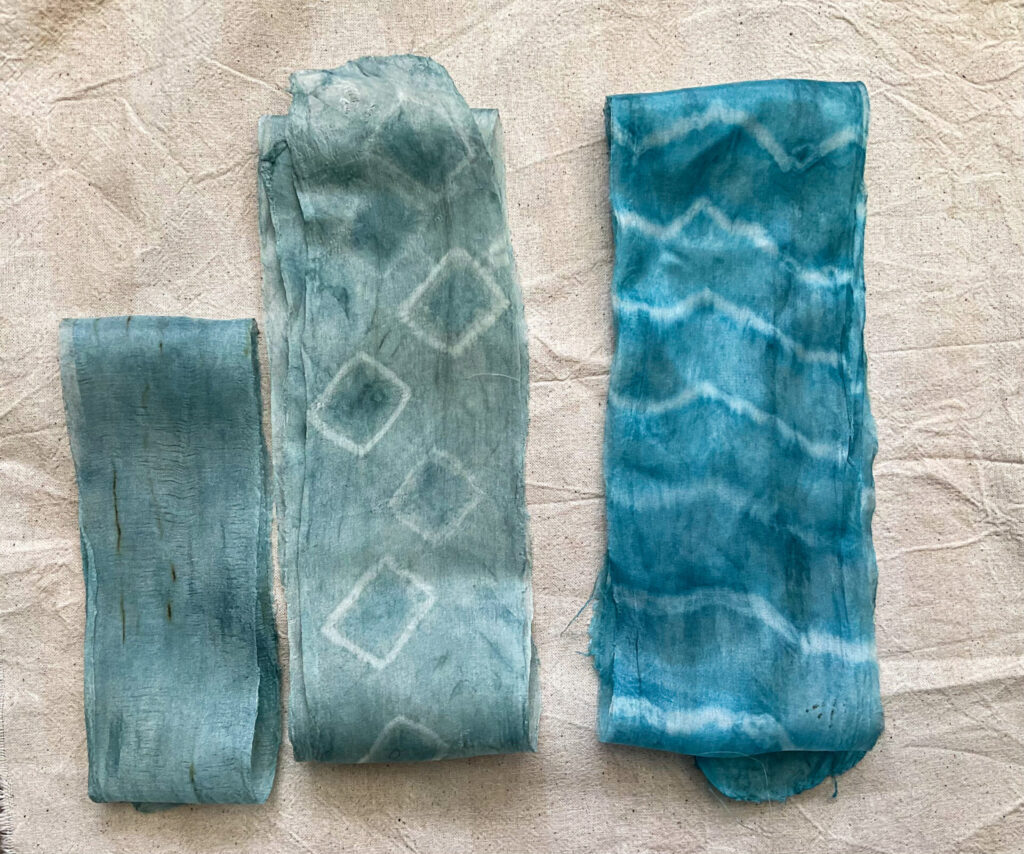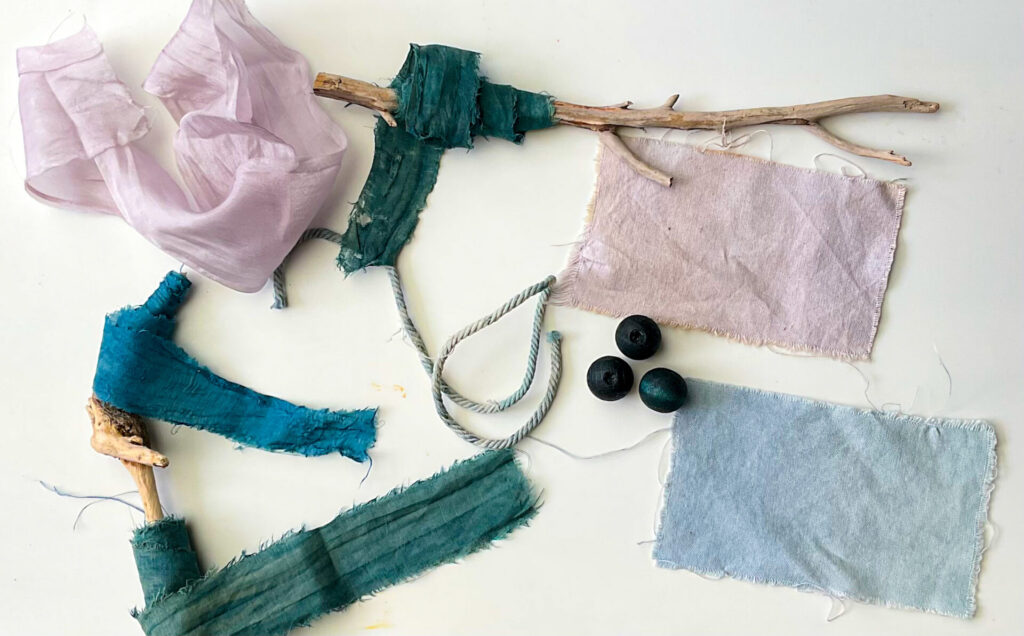Uncover the hidden hues of Japanese Indigo—a blend of science, art, and patience!
When we think of Japanese Indigo (Persicaria tinctoria), the first color that comes to mind is its mesmerizing, iconic blue—a hue that has captivated mankind for centuries. However, through research and experimentation, particularly in my attempts to achieve red hues due to the presence of indirubin, I discovered a surprising range of colors, including soft yellows, subtle greys, and purplish tones.
In this article, I will share insights from my experiments with the fresh leaves of Japanese Indigo, practical methods for unlocking its full color potential, and how this process aligns with sustainable art practices.
A Plant of Many Colors: The Science Behind It
The blue of indigo comes from indigotin, a compound that oxidizes when exposed to air, creating the vibrant color we know and love.

However, indigo leaves also contain other pigments and compounds that can be coaxed into view with varying techniques, such as changes in pH and heat treatments. These lesser-seen hues—yellow, grey, and even reddish tones—are more than just happy accidents. They are a reflection of how the plant interacts with its environment and how we as artists can unlock its secrets.

Hues obtained from the leaves of Japanese indigo
My Journey Beyond the Blue
Having cultivated Japanese Indigo for three years now, I’ve learned that the plant is full of surprises. Here are a few key moments from my experiments that unveiled indigo’s hidden colors:
1. Yellow Through Alkaline Heat
While experimenting with silk and macerated Japanese Indigo leaves, I applied heat and slightly alkalized the medium with baking soda. Gradually, the fabric revealed a warm yellow tone—a fascinating transformation! This shift likely occurs because the heat and alkalinity disrupt the structure of indican, limiting indigo formation, while allowing other pigments like flavonoids (such as kaempferol and quercetin) to take the spotlight, creating the warm yellow tones. These conditions suppress the dominance of blue indigo and highlight the plant’s hidden color palette.
2. Gentle Grey -Blue Tones
During a fresh-leaf dyeing workshop with the school children of Freie Waldorf School Graz, I observed that some fabrics developed a soft grey-blue finish instead of the expected blue. This appeared to be caused by the release of heat as the children processed the leaves, with some compacting them so tightly that the bundles of leaves and fabric warmed during oxidation or interacted with other plant materials. The resulting muted grey is delicate and earthy—a quiet reminder of the plant’s remarkable versatility.

3. Greenish Hues Through Acidic and Alkaline Layers
While working with silk fabric pre-soaked in an acidic medium and fresh leaves of Japanese indigo, I initially observed no reaction. Later, I introduced leaves from an alkaline medium, and over time, subtle neon-bluish-green tones began to emerge. This slow, evolving transformation felt like witnessing nature craft its own intricate masterpiece.

Green hues (L) derived from the fresh leaves of Japanese Indigo.
4. Revealing Reddish Hues from Fresh Japanese Indigo Leaves
Red tones were achieved on silk using fresh Japanese indigo (Persicaria tinctoria) leaves by focusing on indirubin, the red pigment present alongside indigo. The fresh leaves were gently crushed onto the silk, ensuring minimal oxidation by working quickly and keeping the leaf bundles compact. Gentle heat, such as light steaming, was introduced to encourage the red hues without fully oxidizing the indigo. The silk had been pre-soaked in a slightly acidic solution, like vinegar, to further enhance the reddish tones. The result was a soft, reddish or purplish hue—a delicate contrast to the iconic blue.

How You Can Explore Indigo’s Full Palette
Uncovering indigo’s hidden hues is a delightful combination of science, art, and patience. Here’s how you can get started:
- Play with pH:
- Use baking soda for alkaline baths to create subtle transformations.
- Try vinegar for an acidic approach and observe the gradual changes.
- Experiment with Heat:
- Heat dyed fabrics gently in an alkaline or acidic solution to alter the color profile.
- Layer Techniques:
- Combine dye baths for unexpected effects. Start with blue and add acidic or alkaline treatments.
- Document Everything:
- Keep a journal with detailed notes and swatches of your results—it’s invaluable for refining your techniques.
- Be Patient:
- Allow time for the colors to fully develop, as sometimes experiments don’t yield the expected results.
Sustainability Through Curiosity
Exploring the full potential of a single dye plant is both an artistic and sustainable practice. By maximizing every part of Japanese Indigo, we honor the plant’s value, reduce waste, and deepen our connection with nature’s palette. These slower, intentional practices remind us to tread lightly and create art that respects the environment.

The cultivation of Japanese indigo in the foreground, Freie Waldorfschule Graz, Austria
Japanese Indigo is a remarkable plant that offers far more than just its iconic blue. Through experimentation and a deeper understanding of its chemistry, we can unlock a range of hidden colors—from soft yellows and delicate greys to soft pink hues. By exploring these colors, we not only expand our creative possibilities but also embrace a sustainable approach to art. This journey into the full spectrum of Japanese Indigo is a reminder that nature’s beauty is often layered and waiting to be discovered.
Explore the Art of Dyeing with Fresh and Dried Leaves of Japanese Indigo
If you’re eager to explore these colors further, I invite you to dive into my newly published book, A Guide to Dyeing with Fresh and Dried Leaves of Japanese Indigo. In this guide, I share the techniques and insights I’ve gathered from years of experimentation. And, as a special bonus, purchasing the book will grant you free access to an exclusive webinar where we’ll delve deeper into these processes. I look forward to guiding you on this exciting, sustainable dyeing journey!





No Comments